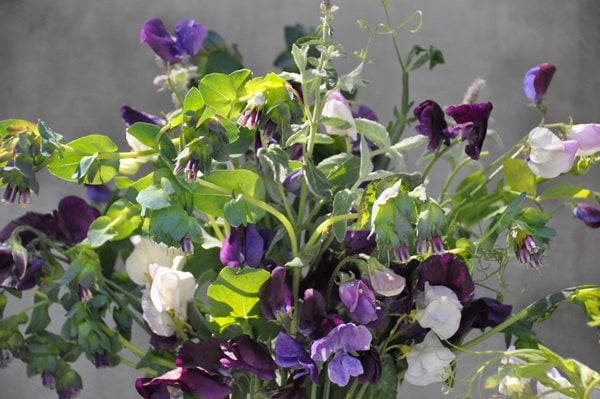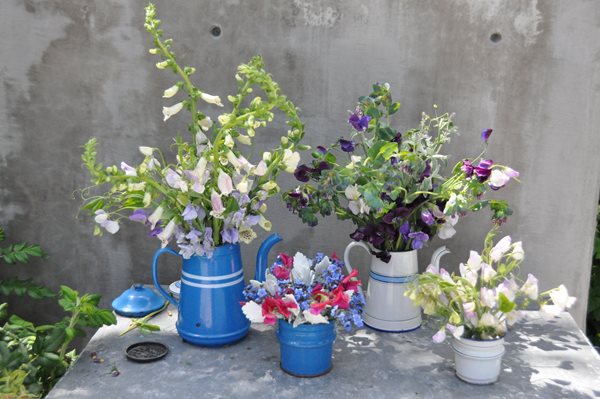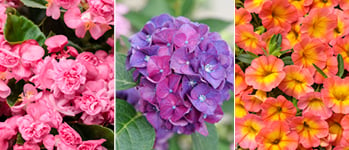Growing and Arranging Sweet Peas
Katherine Anderson, of Marigold and Mint, shows how to plant and harvest sweet peas (including how to create a lattice wall) and how to arrange these delicate flowers into sassy summer centerpieces.

175 Feet of Sweet Peas
As some readers might know, I run Marigold and Mint, my flower shop, and I also grow most of my own flowers, on an organic farm. There are a lot of filthy fingernails, sunburns, and sore backs that go with flower farming, but nevertheless, there are some mornings in the field that remind me with complete clarity why I’ve chosen this path.
In July, I am reminded of the joy of having a flower farm while weeding the beds next to my 175 feet of sweet peas. As the sun dries the dew on the flowers, the scents of my favorite varieties accompany me while I work with my hula hoe. I couldn’t possibly want to be anywhere else.
Marigold and Mint is an organic farm, a retail shop, and a studio. The farm is situated along the Snoqualmie River, about 30 miles east of Seattle and the shop is located in the Melrose Market on Capitol Hill in Seattle, Washington..
Read more on how to grow sweet peas.

Preparing the Trellis for the Sweet Peas
It takes a lot of work to get to the point where the sweet peas are blooming and I can cut them for the shop.
In the spring, after the fields have been tilled and the beds shaped, we build the trellis. Six-foot tall metal stakes are pounded into the ground, spaced 20 feet apart. We stretch a plastic grid (we use Hortonova) between the stakes, looping the top of the grid over the top of each stake, then threading twine taut along the top of it all. To tighten it up further, I sometimes wind twine through the mesh, around and down each pole. Sometimes, I also need to trim off a row or two of the grid on the bottom, bringing it up about 6 inches from the soil.

Build Your Own Wall of Sweet Peas
It's easy to construct a miniature version of my sweet pea setup in your backyard, creating a seasonal wall of sweet peas. For a smaller wall, I've also just hammered nails in vertical lines on a fence, facing the sun, stringing wire between them, to create a mesh for the climbing sweet peas.

The Monk and the Sweet Peas
The 17th-century Sicilian monk Francis Cupani is credited with being the first to cultivate sweet peas (Lathyrus odoratus). I grow this multi-hued purple one named after the monk (‘Cupani’s Original’), and while its stems are shorter than many of the modern hybrids, the intense scent and color make it worthwhile.

A Rainbow of Sweet Peas
I also grow ‘Blue Celeste,’ ‘April in Paris,’ and ‘Watermelon,’ among others, starting my seeds in trays in the unheated hoophouse around President’s Day. But you can also plant them directly outside as soon as the soil can be worked.
Sweet peas need the coolness of early spring, and then plenty of sunshine to bloom. Once my starts are a few inches tall, I transplant them in rows along both sides of the trellis, nestling the starts quite close to each other as this helps them thrive.

Cherries and Sweet Peas
In the Victorian era, it was popular to arrange sweet peas with mignonette flowers. "Mignonette" means little darling, but you could say they same of the sweet pea. With tissue-thin ruffly petals, affixed to a bright green stem, sweet peas can be soft or bold in color, or pure white, which I never have enough of for the July brides.
About the time I start picking the sweet peas—and it's important that the flowers be harvested before the sun gets too high, or else wait until the evening—it’s also time to pick pie cherries from a tree near our barn. This year the colors of my pie inspired me to pull together some sassy sweet pea centerpieces for this column.

Coffeepots!
While I was looking around my house, I found these enamel French coffeepots, and I thought they might be just right for the type of arrangements I was envisioning.

Foxglove and Sweet Peas
Using a finely toothed metal flower frog, I arranged five stems of foxglove in the bright blue coffeepot, finding a height and flow among the stalks that felt right. To this I added ‘Blue Celeste’ and some lavender sweet peas, some still attached to the vine.

A Smaller Arrangement with Dusty Miller and Forget-Me-Not
Within each coffee pot is a small tin for filtering the grounds, and with this, you can make another arrangement; here, I combined sweet peas with dusty miller and Chinese forget-me-not.

Cerinthe as a Base
In another coffeepot, I propped up purple-tipped cerinthe with a flower frog in the bottom, allowing the stems to weave and dip, yet remain deliberately arranged.

Adding the Sweet Peas and Mint
Then I added a range of purple sweet peas, as well as a few stems of soft green mint.

'April in Paris'
With the little cup, a simple clutch of ‘April in Paris’ sweet peas felt right.

Four Festive Arrangements
I think the four arrangements grouped together would feel festive and bright for a backyard dinner party.

Without getting too far into talking about seed politics, we small farmers think and worry about seed varieties being lost. Hybrids are developed, for example, to increase stem length or longevity, but the scent can be left behind in the new varieties. For me, the fragrance of sweet peas is so lovely and I often encourage customers in the store to smell the bouquets.
I know that if all the fragrance is ever bred out of sweet peas, I will hang up my hula hoe. So sweet peas are a reminder to me to save seeds, and to grow and sell the most fragrant varieties. I love these delicate blooms of summer and their perfume, and I can't imagine a July without their beauty.




